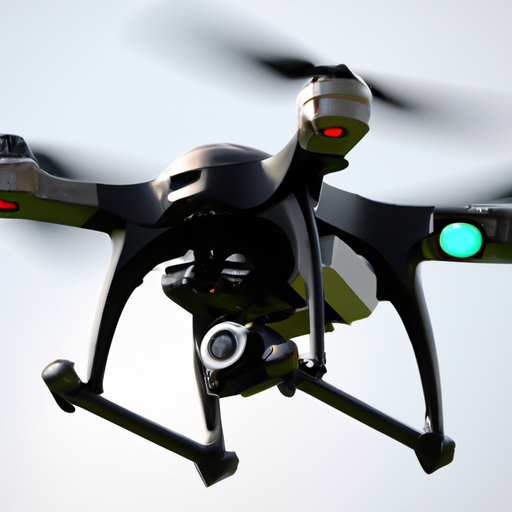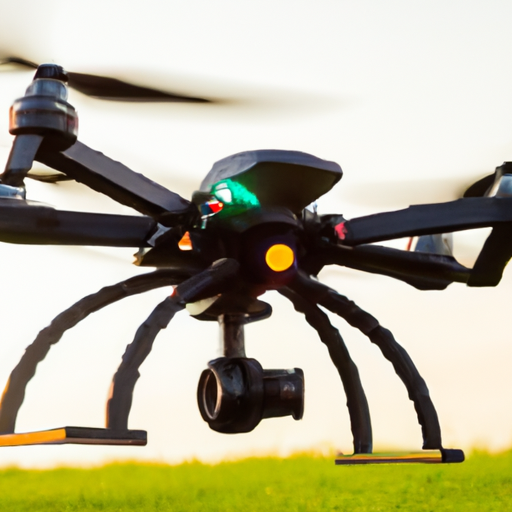You’re about to embark on a fascinating journey with the comprehensive guide “How To Launch And Land Drones Smoothly.” This enticing manual, packed with step-by-step instructions and easy-to-understand explanations, is a precious tool for drone enthusiasts like you who want to master the art of smooth drone takeoff and landing. Strap in folks, because your drone flying skills are about to hit new heights!
Understanding The Basics Of Drone Operation
Operating a drone can be an exciting hobby or a valuable tool for various professions. To get started, though, you first need to fully understand the basics of drone operation. From defining what a drone is to learning different types of drones, this initial section aims to lay the foundation of your knowledge about drones.
Defining what a drone is
A drone, also referred to as an unmanned aerial vehicle (UAV), is a type of aircraft that can operate without a human pilot onboard. These devices can come in varying sizes and can be controlled remotely or run autonomously using pre-programmed flight paths.
Understanding the principle of drone flight
The principle of drone flight is largely based on the principles of conventional airplane flight. However, drones operate by the rotation of its propellers in the air, creating a lift. The motor spins the propellers, creating drafts of air that allow the drone to rise, hover, or move in different directions.
Knowing basic drone terminologies
There are numerous drone terminologies you need to be familiar with, such as the drone’s pitch, roll, and yaw. The pitch refers to the drone’s forward and backward tilt. The roll, on the other hand, is its side-to-side tilt, while the yaw represents the drone’s rotation around its center axis.
Types of drones
There are several types of drones including fixed-wing drones, single-rotor drones, multi-rotor drones, and hybrid drones. Each type varies greatly, mostly in terms of flight times, speed, and the specific functions they are designed for.
Understanding Drone Components And Their Functions
Understanding how a drone works primarily requires knowledge of its various components and their functions. Key parts of a drone include the propellers, motors, battery, controller, and, in some cases, a camera.
The Propellers
The propellers are crucial for a drone’s flight as they create the necessary lift through air resistance. They spin at high speeds, thereby creating a difference in air pressure between the top and bottom surfaces, which ultimately lifts the drone off the ground.
The Motors
The motors generate the power necessary for spinning the propellers. Depending on your drone, it could have one or several motors. Multi-rotor drones typically require more motors to ensure a balanced and controlled flight.
The Battery
The battery powers the drone and its systems. It’s a critical component since it determines how long your drone can stay in the air. As such, choosing a drone with a reliable battery can lead to longer flight times.
The Controller
The controller, also referred to as the remote control, allows you to pilot the drone. It communicates your commands to the drone during the flight. Understanding the functions of the controller’s various buttons and sticks is crucial to flying your drone effectively.
The Camera
Most drones are equipped with cameras, especially those designed for photography and videography. The camera can capture aerial photos and videos, providing you a completely different perspective of your surroundings.

Assembling Your Drone Correctly
Once you have a comprehensive understanding of the drone and its parts, the next step is assembling your drone correctly. This involves knowing what your drone kit includes and learning how to set everything up properly.
Knowing what drone kit includes
A typical drone kit includes the drone itself (frame, motors, propellers), a controller, a battery, and a user manual. Some kits may also include additional accessories such as extra propellers, a carrying bag, or a charging dock.
Attaching the propellers
Attach the propellers to the drone’s motors making sure they are securely fastened. Keep in mind that certain drones have different propellers for clockwise and counter-clockwise rotation, so make sure to attach these correctly based on the user manual.
Installing the battery
After attaching the propellers, connect the battery to the drone and secure it as per the instructions. Be sure to check if the battery is fully charged before installing it.
Setting up the controller
The next step is setting up the controller. This involves inserting the required batteries and pairing it with the drone. Most drones use a radio signal for this pairing, and the process varies from one drone model to another.
Booting up and connecting the drone
When everything is set up, switch on the drone and controller. Most drones automatically connect once both devices are switched on. If not, refer to the user manual to manually connect the two.
Knowing Your Drone Controller
Getting to know your drone controller is critical to a successful flight experience. The controller acts as the direct communication link between you and your drone in mid-flight.
Understanding various drone controller components
A typical drone controller consists of two main control sticks, buttons for power, taking photos or recording videos, and various other controls for advanced flight modes.
The functions of drone controller buttons
The functions of each button or stick on a drone controller will depend on the drone model. Typically, one control stick adjusts the altitude and rotates the drone, while the other stick controls forward, backward, and side-to-side movements. Buttons can be used for power, starting or stopping video recording, capturing photos, and engaging advanced flight modes.
Preparing the drone for flight
Before you initiate the flight, make sure that both your drone and controller have sufficient battery power, and ensure the drone is on level ground before takeoff. Typically, you start the motors by pushing both control sticks to their bottom corners.

Launching Your Drone
Launching your drone is an exhilarating experience. However, you need a clear understanding and mindful consideration of certain elements to ensure a successful takeoff.
Checking the drone’s condition before takeoff
Before launching your drone, ensure it is in a good condition. Check for any damage, make sure all components are secure, ensure the battery is fully charged, and verify that the drone is properly linked to the controller.
Understanding your surroundings
Assessing your surroundings is crucial before launching your drone. Avoid launching your drone in crowded areas, near buildings, or under trees to prevent collisions. Make sure you are in a safe, open space and be aware of local regulations about where drones can be flown.
Start-up procedures
Typically, you start the motors by pushing both control sticks to their lower corners. Once the motors start spinning, you can slowly increase the throttle using the left stick to lift the drone off the ground.
How to lift off smoothly
To lift off smoothly, gently push the throttle until the drone begins to lift off the ground. Continue to push the throttle until the drone reaches your desired altitude. Remember to maintain control of the drone and monitor its movements carefully.
Managing In-Flight Control
Once your drone is airborne, managing in-flight control becomes crucial. It’s key to remember that maintaining control in the air is not just about maneuvering, but also about understanding direction, height, and speed management.
Maintaining control in the air
While in flight, keep your drone within line of sight and pay attention to its movements. Use small, gentle movements on the controller to steer the drone effectively.
Understanding directional control
In drone terminology, forward and backward movement is known as pitch, while side-to-side movement is called roll. Turning left or right without changing the drone’s position is referred to as yaw. Mastering these controls will allow you to fly your drone efficiently in any direction.
Height and speed management
Managing your drone’s height and speed is crucial. Using the throttle on your controller, you can control the height of your drone. Additionally, using the pitch and roll controls can increase or decrease the drone’s speed in different directions.
Correcting drift and balance
Depending on your drone’s settings, you may need to correct drift and balance mid-flight manually. Adjusting the controller’s trim settings can help correct any balance issues and steady your drone’s flight.
Mastering Different Flight Modes
Modern drones come equipped with a variety of flight modes. Each mode can contribute to different flight experiences and provide various levels of control. Understanding each mode can be beneficial for a rewarding drone operation experience.
Beginner mode
Beginner mode is designed for first-time flyers. This mode limits the speed and range of the drone, making it easier to control.
GPS mode
GPS mode allows your drone to hover steadily and return to its original takeoff point if it goes out of range or if the battery is low. This mode relies on a GPS satellite signal to maintain a stable flight.
Sports mode
Sports mode enables your drone to reach higher speeds and is perfect for racing or following fast-moving subjects. This mode is recommended for experienced pilots due to the increased speed and sensitivity of controls.
Attitude mode
Attitude mode or ‘Atti’ mode will maintain your drone’s level during flight, but disables GPS hold. This means your drone will drift with the wind and won’t hold a steady position, making it best suited for more advanced pilots.
Return to home mode
In ‘return to home’ mode, the drone will automatically return to the location from where it took off either at the press of a button or when the battery is low. This feature can be a lifesaver if you lose sight of your drone.
Effective Drone Landing Techniques
Landing your drone is as important as launching it. The landing process involves careful preparation, choosing a suitable landing spot, and understanding how to reduce speed for landing.
Preparing for landing
As you prepare to land your drone, check the surroundings for any obstacles. Reduce the altitude slowly to bring the drone closer to the ground.
Choosing a suitable landing spot
Choose a flat, clear area for landing your drone. Make sure there are no people, animals, or sensitive objects nearby that could be hit by the drone.
How to reduce speed for landing
Reduce your drone’s speed by slowly lowering the throttle on the controller. This should be done gradually to avoid crashing the drone into the ground.
Landing your drone safely
When your drone is a few feet from the ground, continue lowering the throttle until the drone touches down. Once it has landed, lower the throttle all the way to stop the propellers from spinning.
Dealing With Emergencies
Despite your best efforts, emergencies can occur during drone flights. This can range from technical malfunctions to lost drones. Here’s how to handle these situations.
Handling sudden malfunctions
Should your drone malfunction mid-flight, stay calm and consider activating the drone’s ‘return to home’ function. If your drone starts behaving erratically, try to steer it to an open space before attempting a controlled descent.
Utilizing failsafe functions
Most drones are equipped with failsafe functions such as ‘return to home’ mode or auto-landing feature, which can be activated if you lose control of the drone. Familiarize yourself with these functions before you begin flying.
Retrieving lost drones
If you lose your drone, don’t panic. Use the GPS data from your drone controller to locate its last known position. Some drones also have ‘beep’ features that emit a sound when they are lost, making them easier to find.
Dealing with drone crashes
In the unfortunate event of a crash, first, ensure there is no further risk of injury to people or damage to property. Then, retrieve your drone and assess the damage. In some cases, you may be able to replace certain components; in others, a professional repair may be needed.
Maintaining Your Drone for Optimum Performance
Regular drone maintenance is essential to ensure your drone operates at optimum performance and prolongs the drone’s lifespan. Here are a few tips for maintaining your drone.
Regular drone checkup
Perform regular check-ups on your drone. Look for any damages, check the propellers for cracks, ensure that the motors are not clogged with dirt, and ensure all firmware is updated.
Replacing damaged components
If any part of your drone is damaged, such as a propeller or a motor, replace it as soon as possible to avoid further damage or sub-par performance.
Battery care
Taking care of your drone’s battery is crucial. Always ensure the battery is fully charged before a flight and avoid overcharging or extreme temperatures as they can degrade the battery’s performance over time.
Storing your drone properly
Store your drone in a clean, dry place when not in use. Take out the battery and ensure the drone is clean before storage. If your drone came with a carrying case, make use of it as it is designed to protect your drone during storage and transportation.
Learning to operate a drone involves understanding the basics, getting to know your drone and its controller, practicing safe takeoff, and landing techniques, managing in-flight control, mastering different flight modes, and dealing with emergencies. With a well-performed maintenance routine, your drone should offer you many hours of enjoyable flight. Happy flying!



